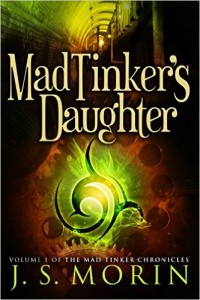 Relying more on nuance than gross difference to separate cultures and places, Morin creates a world that is both obviously not our own and immediately recognisable as real. While this novel does not skimp on either action or fantastical technologies, it is also strongly founded in character and not novelty.
Relying more on nuance than gross difference to separate cultures and places, Morin creates a world that is both obviously not our own and immediately recognisable as real. While this novel does not skimp on either action or fantastical technologies, it is also strongly founded in character and not novelty.
Rynn lives in a world where most humans are slaves to other races. Eking out a living as a University cleaner, she spends her free time building devices to fight against her oppressors. Madlin Errol is the daughter of the Mad Tinker, one of the most powerful and respected engineers in her world. But they are also the same person: when one sleeps they awaken as the other. Madlin’s father is gathering all those humans who share this power of split lives for some grand and secret scheme, but Rynn sees too much injustice in the world to wait. With both great talent and twice as much time to experiment, she can make a difference: but will she also make things worse?
The idea of people’s dream lives being real is not new. However, Morin’s take on it feels fresh. Rather than the common tropes of the dream realm being malleable, fickle, surreal, or in otherwise unlike reality, the twin realms of Korr and Tellurak are – while different in culture and environment – both “reality”. This equality removes the inherent bias that might otherwise make the reader automatically choosing the real world over illusion; and thus makes the conflicts between benefiting one or the other more resonant.
While each world is rendered realistically, they are both solidly fantasy worlds, possessing technologies on the border between magic and alternative science.
Korr, the world of oppressed humanity and ancient powerful races, has the decayed grandeur of a long past and a mysticism grown from slavery and decadent civilisation.
Whereas, Tellurak, a world apparently solely of humans, has the entrepreneurial shininess of a world filled with the free and ruled by those who escape their slavery by sleep.
But both also share common themes: the plans of the powerful are handed down in pieces with the expectation they are both benevolent and right; and progress belongs to those who make it. This creates a reason to favour one over the other, while adding a suspicion that neither is actually a great society.
Rynn/Madlin is a skillfully written protagonist; or protagonists, as the divided personalities present differently to the different worlds. As Rynn she lives a secret life as a terrorist, using her public face only to eavesdrop on engineering lectures and sneak texts from the library. As Madlin, she is free to study and experiment, but still rebels against her father’s belief that she doesn’t need to know his full plans.
However, Madlin/Rynn’s youthful rebellions, might also be the part least engaging to the reader. Despite, or perhaps because of, Morin’s plausible portrayal of the mixture of poor impulse control and iron self-belief of a teenager, there are moments when a reader who prefers protagonists with a mature outlook might feel frustrated by the lack of introspection and trust.
This portrayal of distinct but similar masks on an inferred core extends to several of the other twinned characters in the novel, giving a stronger and more nuanced insight into the two cultures by evidence of their effect on different people.
However, by displaying that the persona of a character in one world might not reflect their plans in the other, Morin also undermines the reader’s certainty that a twinned character seen from the perspective of only one world is as they seem. Combined with open collaboration from some characters, this makes each time Madlin trusts someone in Tellurak take on the undertone of possible betrayal, adding a resonance of conspiracy that reduces the reader’s distance.
Although the shared worlds and the characters who exist in both are at the heart of this book, Morin does not skimp on the single-world narratives. Those confined to one world face problems of equal scale and complexity, and are rendered with equal depth; and those who can switch between worlds, find neither life merely an obstacle to or tool for their goals in the other.
Overall, I really liked this novel. I recommend it to readers seeking a solid steampunk adventure with complex dilemmas.
About The Reviewer

Dave Higgins writes speculative fiction, often with a dark edge. Despite forays into the mundane worlds of law and IT, he was unable to escape the liminal zone between mystery and horror. A creature of contradictions, he also co-writes comic sci-fi with Simon Cantan.
Born in the least mystically significant part of Wiltshire, England, and raised by a librarian, he started reading shortly after birth and hasn’t stopped since. He lives with his wife, two cats, a plush altar to Lord Cthulhu, and many shelves of books.
It’s rumoured he writes out of fear he will otherwise run out of books to read.
Learn more about Dave and his work at http://davidjhiggins.wordpress.com/
 Remember the end of “eXistenZ”? In the 1999 movie starring Jennifer Jason Leigh and Jude Law, they—and we—left that final scene unsure if it was yet another stage in the virtual reality presentation. Jude Law’s character, “virtual reality virgin” Ted Pikul, was pulled and shoved from one insanity to the next by his ignorance of whether he was in a real world or in the virtual reality game.
Remember the end of “eXistenZ”? In the 1999 movie starring Jennifer Jason Leigh and Jude Law, they—and we—left that final scene unsure if it was yet another stage in the virtual reality presentation. Jude Law’s character, “virtual reality virgin” Ted Pikul, was pulled and shoved from one insanity to the next by his ignorance of whether he was in a real world or in the virtual reality game. Graduated from Colorado School of Mines with a degree in Geological Engineering (mining geology/economics). Married to a CSM mining engineer for 45+ years now. Has 10 brothers and sisters, could fill a small concert hall with nieces, nephews, and their children.
Graduated from Colorado School of Mines with a degree in Geological Engineering (mining geology/economics). Married to a CSM mining engineer for 45+ years now. Has 10 brothers and sisters, could fill a small concert hall with nieces, nephews, and their children.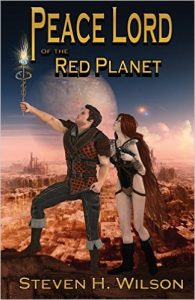
 WHILE STAR WARS and STAR TREK seeded J. Daniel Sawyer’s passion for the unknown, his childhood in academia gave him a deep love of history and an obsession with how the future emerges from the past.
WHILE STAR WARS and STAR TREK seeded J. Daniel Sawyer’s passion for the unknown, his childhood in academia gave him a deep love of history and an obsession with how the future emerges from the past.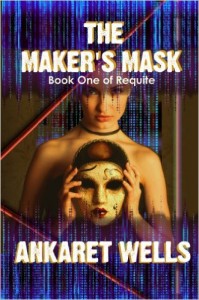

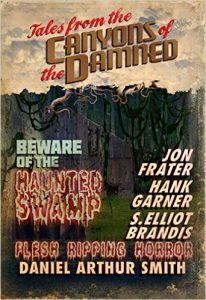
 Deanne Charlton is a well-traveled writer whose first book was a construction paper tome of 16 pages at age 8. She tortured her parents with homemade stage plays, using a sliding glass door to introduce characters. Eventually, she segued into real life, fulfilling a college degree and practicing several professions, and then she retreated to her make-believe world and the friends it now presents. While comfortable with poetry, she ventures into prose upon occasion, including short stories, essays, and book reviews. She curates a writer-dense Facebook group at DCharltonEdits, provides editing services, and tweets as @dcwrites. She is tender, fierce, and loyal.
Deanne Charlton is a well-traveled writer whose first book was a construction paper tome of 16 pages at age 8. She tortured her parents with homemade stage plays, using a sliding glass door to introduce characters. Eventually, she segued into real life, fulfilling a college degree and practicing several professions, and then she retreated to her make-believe world and the friends it now presents. While comfortable with poetry, she ventures into prose upon occasion, including short stories, essays, and book reviews. She curates a writer-dense Facebook group at DCharltonEdits, provides editing services, and tweets as @dcwrites. She is tender, fierce, and loyal.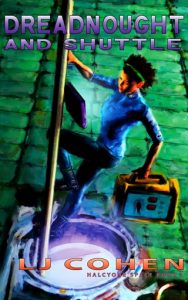
 Husband, father, and researcher, Ryan Toxopeus spends his free time working on his epic fantasy trilogy, Empire’s Foundation. He started writing the first book, A Noble’s Quest, in 2010 and fell in love with all aspects of storytelling. He focuses on fast paced, character driven plots. His motto: “If I’m bored writing it, others will be bored reading it.”
Husband, father, and researcher, Ryan Toxopeus spends his free time working on his epic fantasy trilogy, Empire’s Foundation. He started writing the first book, A Noble’s Quest, in 2010 and fell in love with all aspects of storytelling. He focuses on fast paced, character driven plots. His motto: “If I’m bored writing it, others will be bored reading it.”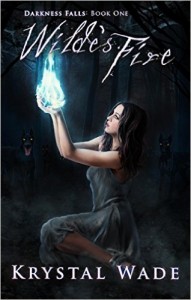
 Samantha Bryant is a middle school Spanish teacher by day and a mom and novelist by night. That makes her a superhero all the time. Her debut novel, Going Through the Change: A Menopausal Superhero Novel is now for sale by Curiosity Quills.
Samantha Bryant is a middle school Spanish teacher by day and a mom and novelist by night. That makes her a superhero all the time. Her debut novel, Going Through the Change: A Menopausal Superhero Novel is now for sale by Curiosity Quills.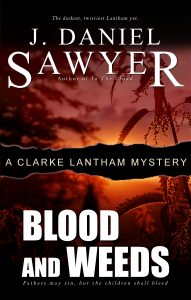
 Some creatures feed on blood and revel in the screams of their prey. Scott Roche craves only caffeine and the clacking of keys. He pays his bills doing the grunt work no one else wants to take, bringing dead electronics back to life and working arcane wonders with software. His true passion is hammering out words that become anything from tales that terrify to futuristic worlds of wonder. All that and turning three children into a private mercenary army make for a life filled with adventure.
Some creatures feed on blood and revel in the screams of their prey. Scott Roche craves only caffeine and the clacking of keys. He pays his bills doing the grunt work no one else wants to take, bringing dead electronics back to life and working arcane wonders with software. His true passion is hammering out words that become anything from tales that terrify to futuristic worlds of wonder. All that and turning three children into a private mercenary army make for a life filled with adventure.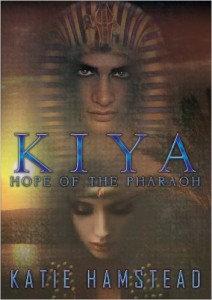
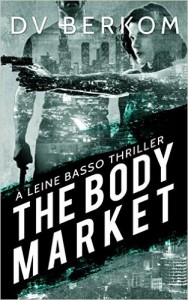
 Elisabeth Zguta is an advocate for Independent authors and publishers and encourages all writers to learn the skills needed for today’s book markets and to keep in touch with the new technologies.
Elisabeth Zguta is an advocate for Independent authors and publishers and encourages all writers to learn the skills needed for today’s book markets and to keep in touch with the new technologies.